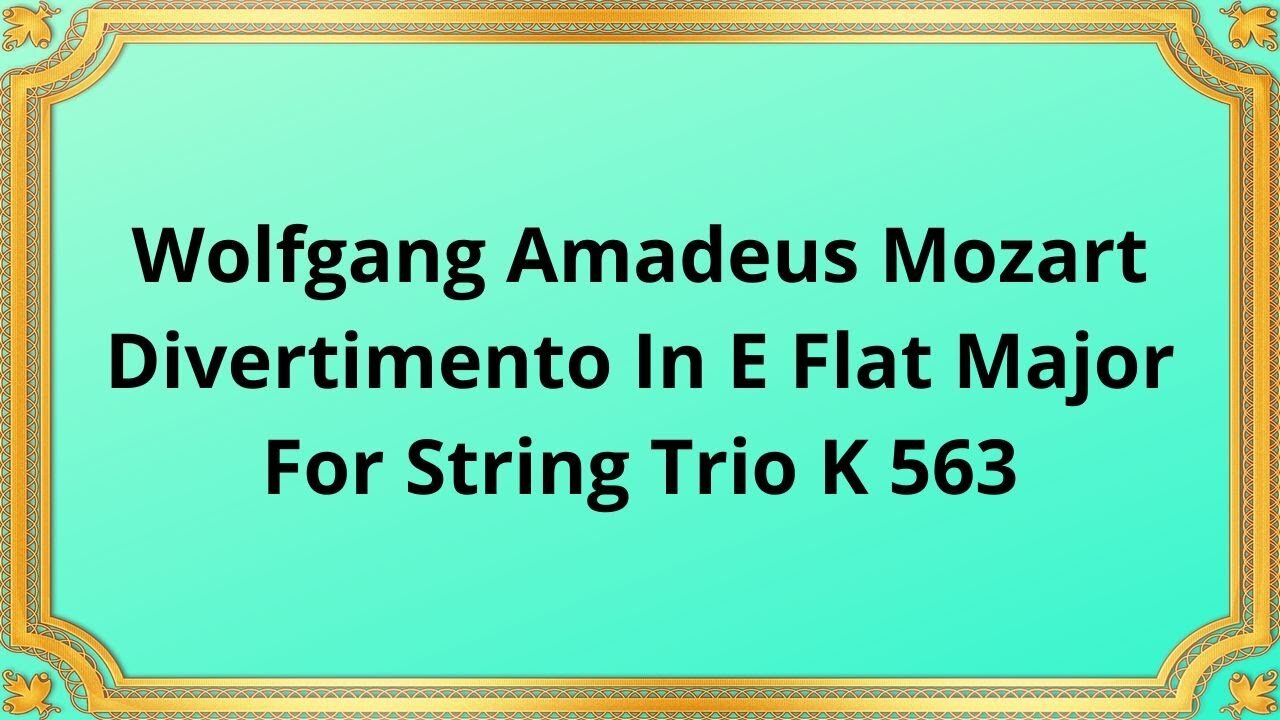Premium Only Content

Wolfgang Amadeus Mozart Divertimento In E Flat Major For String Trio K 563
#Mozart#Chamber_music#Classical_music#Divertimento#Musical_composition
Publication date 1953
FREDERICK CRAIG RIDDLE Viola
ANTHONY PINI Cello
JEAN POUGNET Violin
Wolfgang Amadeus Mozart's Divertimento in E-flat major for String Trio, K. 563, is a masterpiece of classical chamber music that showcases the composer's mastery of melody, harmony, and form. Composed in 1788, the Divertimento is scored for violin, viola, and cello and is often considered one of Mozart's greatest chamber works.
The Divertimento is in six movements, with the first and last movements in sonata form, the second and fifth in a minuet and trio form, and the third and fourth movements in a slow andante and a lively allegretto, respectively. The work is notable for its beautiful melodies, intricate harmonies, and expertly crafted counterpoint.
The opening movement, marked "Allegro," features a lively and energetic theme that is passed between the violin, viola, and cello. The movement showcases Mozart's skill in developing a musical idea and weaving it throughout the entire composition.
The second movement, marked "Adagio," is a slow and contemplative piece that features a beautiful and expressive melody played by the violin. The viola and cello provide a rich and harmonious accompaniment, creating a serene and introspective atmosphere.
The third movement, marked "Menuetto," is a graceful and elegant dance in triple meter. The trio section, marked "Trio," features a contrasting melody that is played by the viola and cello.
The fourth movement, marked "Andante," is a slow and stately piece that features a beautiful and expressive melody played by the violin. The viola and cello provide a rich and harmonious accompaniment, creating a serene and contemplative atmosphere.
The fifth movement, marked "Menuetto," is a lively and playful dance in triple meter, with the trio section featuring a contrasting melody played by the violin and viola.
The final movement, marked "Allegro," is a fast and lively piece that brings the Divertimento to a thrilling conclusion. The movement features a catchy and memorable melody played by the violin, which is then developed and expanded upon by the viola and cello.
Overall, Mozart's Divertimento in E-flat major for String Trio, K. 563, is a masterpiece of classical chamber music that showcases the composer's genius and the virtuosity of the performers. Its beautiful melodies, intricate harmonies, and expertly crafted counterpoint make it a must-listen for any lover of classical music.
In terms of its historical context, the Divertimento was composed during a time of great innovation and experimentation in classical music. The piece is often classified as belonging to Mozart's "late period," during which he produced some of his greatest works, including the famous Requiem Mass in D minor.
In conclusion, Wolfgang Amadeus Mozart's Divertimento in E-flat major for String Trio, K. 563, is a masterpiece of classical chamber music that showcases Mozart's genius and the virtuosity of the performers. Its beautiful melodies, intricate harmonies, and expertly crafted counterpoint make it a must-listen for any lover of classical music.
-
 2:12:18
2:12:18
TheDozenPodcast
23 hours agoIslam vs Christianity: Bob of Speakers' Corner
84.9K16 -
 14:36
14:36
The StoneZONE with Roger Stone
1 day agoRoger Stone Delivers Riveting Speech at Turning Point’s AMFEST 2024 | FULL SPEECH
108K25 -
 18:59
18:59
Fit'n Fire
13 hours ago $6.41 earnedZenith ZF5 The Best MP5 Clone available
63.1K2 -
 58:34
58:34
Rethinking the Dollar
22 hours agoTrump Faces 'Big Mess' Ahead | RTD News Update
49K5 -
 5:35
5:35
Dermatologist Dr. Dustin Portela
22 hours ago $2.30 earnedUnboxing Neutrogena PR Box: Skincare Products and Surprises!
62.6K5 -
 11:20
11:20
China Uncensored
22 hours agoCan the US Exploit a Rift Between China and Russia?
74.8K21 -
 2:08:48
2:08:48
TheSaltyCracker
17 hours agoLefty Grifters Go MAGA ReeEEeE Stream 12-22-24
272K709 -
 1:15:40
1:15:40
Man in America
20 hours agoThe DISTURBING Truth: How Seed Oils, the Vatican, and Procter & Gamble Are Connected w/ Dan Lyons
161K141 -
 6:46:07
6:46:07
Rance's Gaming Corner
21 hours agoTime for some RUMBLE FPS!! Get in here.. w/Fragniac
182K5 -
 1:30:48
1:30:48
Josh Pate's College Football Show
21 hours ago $11.54 earnedCFP Reaction Special | Early Quarterfinal Thoughts | Transfer Portal Intel | Fixing The Playoff
112K2